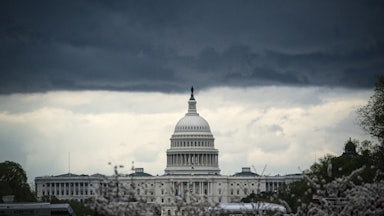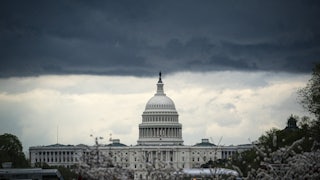The Intergovernmental Panel on Climate Change has released the first, nearly 4,000-page installment of its Sixth Assessment Report. The report, from a working group of over 200 scientists, distills the current consensus about the physical science of climate change from 14,000 peer-reviewed studies. This consensus is grim: None of the emissions scenarios this report highlights see warming kept below 1.5 degrees Celsius (2.7 degrees Fahrenheit). Heat waves previously seen only twice in a century will soon hit every six years, along with a slew of vicious storms and droughts.
Atmospheric levels of carbon dioxide are at their highest point in two million years. We can no longer avoid some of the catastrophic warming coming our way. Avoiding the rest will entail “immediate, rapid, and large-scale reductions in greenhouse gas emissions,” per IPCC Vice Chair Ko Barrett. Most of those reductions need to come from polluting sectors the Biden administration continues to treat with kid gloves.
The point of this report is to identify “not just that it’s getting hot, but at what point things are unbearable,” Alex Ruane, a lead coordinating author on chapter 12 of the report and a research scientist at NASA’s Goddard Institute for Space Studies, told me by phone. That means exploring questions like, “At what point does the engineering of levees start to break?” and how hot airport runways can get before planes stop being able to take off. The report, he stressed, steers well clear of policy recommendations.
There are stark political implications, though. “There is no stable normal until we figure out a way of stabilizing the climate system,” Ruane told me.
In a summer of rolling climate disasters that have made that fact viscerally obvious, politicians around the world have already started offering platitudes about the need for “action” and “ambition.” Yet they mostly haven’t called for the rapid shift off fossil fuels that the report indicates is necessary.
It’s not that politicians in powerful countries have done nothing in the past two decades. The problem, rather, is that where they’ve done anything at all, it has tended to be the wrong thing, emphasizing subtle market tweaks and shiny new technologies instead of the core work of decarbonization: getting off fossil fuels as quickly as possible. There is not some reserve of sensible climate leadership ready to be unleashed if Republicans weren’t standing in the way. Happy talk about net-zero pledges and climate leadership in the last few years obscure decades of bipartisan speeding down the wrong track, toward an imagined future where polluters and the planet can both make out well in coming decades.
U.N. Secretary General António Guterres Guterres called the report a “death knell” for fossil fuels. Having a better than 50-50 shot at capping warming at 1.5 degrees Celsius, the report explains, means the entire world can only emit an additional 400 gigatons of carbon dioxide beyond what it has already emitted; last year global carbon emissions were around 36 gigatons. If emissions stay roughly constant, then—an optimistic scenario, to be sure—the world will cross that threshold in just over a decade. The United States is not poised to help reverse that trend.
The Obama administration consciously chose to get opponents on board with extending clean energy tax credits by, in exchange, lifting the crude oil export ban that had been in place since the 1970s. At the time, clean energy groups framed that devil’s bargain as a win for the planet. The result was that fossil fuel exports and emissions skyrocketed.
The Biden administration is now on track to approve more oil and gas drilling on public lands—activity that accounts for a quarter of U.S. greenhouse gas emissions—than any administration since George W. Bush. Climate envoy John Kerry has balked at the idea of committing the U.S. to a coal phaseout. Politicians who call themselves climate hawks are still going out of their way to make clear that there’s a vibrant future ahead for the companies that funded climate denial, whose business model remains built around burning up and extracting as many fossil fuels as possible. Administration officials, meanwhile, have talked repeatedly about the need to cap warming at 1.5 degrees Celsius.
This is climate denial. These politicians don’t dispute that the climate is changing, but they are absolutely in denial about what curbing it would entail. The report has made clear that the climate in which this country became a superpower no longer exists. So why are politicians stuck on twentieth-century answers to the twenty-first century’s problems?
Rhetorically, the administration has emphasized electric vehicles, in particular, as being at the core of its climate agenda. With the right incentives, the thinking goes, the U.S. can transform a historically important sector into an engine of green job creation and decarbonization. So what is the White House doing to make good on its promise of sparking an E.V. revolution? Last week, the White House announced that it had reached a nonbinding deal with the country’s biggest automakers that half their new vehicles would be electric, plug-in hybrid, or hydrogen-electric by 2030.
That target in fact falls short of what car companies themselves previously pledged. And the funding for the goal is pretty meager, too. Electric vehicles and buses only get $7.5 billion each in the bipartisan infrastructure plan, to be parceled out over 10 years in the form of incentives rather than direct spending. There might be $20 billion more over a decade for E.V. rebates in the reconciliation package advanced on Monday, but not much else.
Showing off a modest pilot project for solar-paneled highways last week, Transportation Secretary Pete Buttigieg claimed the U.S. has entered the race to “win the E.V. market.” This, to put it plainly, is ridiculous. Let’s compare, for example, where the U.S. is to where China is on that front. The U.S. currently has 1,650 electric and fuel cell buses currently or “soon to be” in use. Since 2015, China has rolled out 421,000 electric buses via generous industrial policy that paid automaker BYD the equivalent of $150,000 for every $300,000 electric bus it churned out. That was paired with procurement policies that created a built-in market for what were then still clunky e-buses, forcing manufacturers to work out the kinks as they scaled production to meet demand from the public sector. Shenzhen alone now has 16,000 electric buses, along with some 12,000 E.V. taxis.
The American automobile industry, specifically Ford and GM, have known for over half a century about the threat their products posed to the habitability of the planet. They responded by funding climate denial. The Biden administration is offering these companies free advertising and voluntary incentives to change course. That isn’t treating climate change as a crisis so much as a business opportunity for its favorite sectors.
Simply subbing out every fossil fueled vehicle on the road now for E.V. Hummers and F-150s won’t fix the transportation sector. The country will also have to build charging infrastructure, which gets only token funds in the bipartisan infrastructure deal. Electrified public transit will need to be radically scaled up by offering rapid bus service, train lines, and shared vehicles to millions more people. Cities will need to be designed so that many more people can live closer to where they work and send their kids to school, with protected bike lanes so they can get around. That means investing in green public housing, which thankfully looks like it will get some funding in the reconciliation package. But it also likely means going after real estate empires blanketing major cities with luxury buildings that serve as glorified safety-deposit boxes for oligarchs. And funding Amtrak adequately also means doing battle with freight companies that try to block new passenger lines. That’s before you even get to the need to power the electrical grid with clean energy, so that electric vehicles are truly low- or zero-emission.
Decarbonization is fundamentally a planning problem. The U.S. (among other rich countries) has grown allergic to planning, at least in the areas that might help reduce emissions. Even in the places where it’s most bullish, like E.V.s, the best the administration can imagine is tweaks around the edges. American policymakers aren’t even picking up the tools that have served us in the past. Decades of public policy have hollowed out the kinds of administrative expertise that carried out the New Deal and the war mobilization that followed it, where federal agencies closely regulated the prices of key commodities, nationalized important factories, and created industries virtually whole cloth to feed the war effort. Just plowing money into existing programs—the only thing reconciliation can really do—won’t make those programs more functional or empower their employees to think expansively about their role in solving the greatest challenge humanity has ever faced. Neither can it euthanize the fossil fuel industry.
The physical reality of climate change doesn’t make the politics surrounding it any easier. Thanks to the decades-long push to drag the U.S. political spectrum to the right, any reasonable solutions for dealing with the climate crisis seem all but impossible here. Realistically, at this point, climate leadership will have to come from elsewhere. Whatever climate spending Democrats can eke out of reconciliation is certainly welcome. But something’s gotta give at a much larger scale. The planet we’ve known already is venturing into “unprecedented” territory. Our politics should, too.








